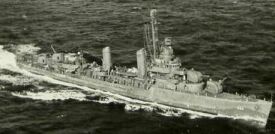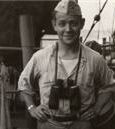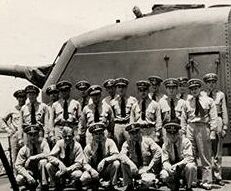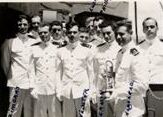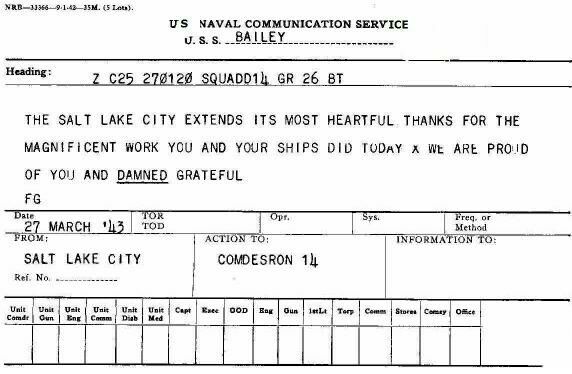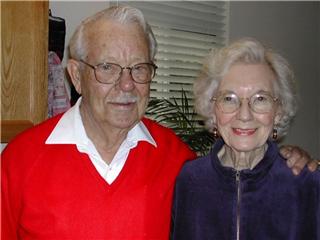|
Stan's story begins shortly after the USS BAILEY joined up with the USS INDIANAPOLIS
We went in to Dutch Harbor, for fuel and provisions. The weather couldnít have been worse. We were in what the natives called a Willywaw--a severe and often sudden storm. Winds along with
snow could hit you at gale force--up to 60 or 70 knots. And the mountainous seas were
treacherous. We had been instructed to tie up to a buoy, but couldnít get close enough to
effect the tie up. Finally, the Captain received permission to drop anchor which he did. But
he took the precaution to instruct the engine room to maintain steam up to the throttle so that
in an instant, we could get underway should that become necessary. After fighting the wind and
seas, anchoring, and writing his orders to the Officer of the Deck, the Captain went below to
his sea cabin for a well deserved rest. I was up on the bridge during the 000 to 0400 watch
when by taking bearings on fixed objects on the shore it was apparent we were moving--or
dragging our anchor.
The Captain was called by shipís phone and the danger reported to him. In a flash he was on
the bridge, dressed only in his pajamas but he had taken a second to get that cigar so I guess
in his mind he was fully dressed. We sent below for a pair of pants, shoes, and his heavy
coat, helped him step into the trousers and put on his coat as he gave orders to the helmsman
and issued instructions to the engine room to make so many turns. Meaning, turn the propellers
so as to make 10 knots, or 20 knots, or whatever was required to keep the ship underway and
avoid being driven aground. Rather quickly we were out of danger of being dragged onto the
rocky shore but we didnít miss by much. It was scary to say the least. Through it all the
Captain was calm, orderly, didnít appear to be excited but was just doing his job. A blinker
signal was received saying the anti-submarine nets that had closed the entrance to Dutch Harbor
had been swept away by the mountainous seas and at the option of our Captain we were free to
proceed out of the harbor to the open sea. Our Captain chose to accept that option and as we
gained the open sea, the mountainous seas swept over us. They hit us from the beam and so we
rolled, rolled to the point of taking some sea water down one of the smoke stacks, and for a
moment, our forward fire room was out of commission. The damage was quickly controlled and
the power restored, otherwise I hate to think what might have happened. The Captain was
finally able to point the bow of the ship into the wind and sea, making her less subject to the
violent rolling. Let me tell you, there were more than a few sea sick sailors that night, even
the old hands who long ago got their sea legs were sick. Me? I was one of the lucky ones,
never had a problem. But food of any kind was not very appealing.
Finally the storm abated and we were able to re-enter Dutch Harbor, tie up to a buoy, and take
on our much needed fuel and provisions. There were three or four days to complete those tasks,
do some maintenance on some of the machinery and otherwise, get the ship ready to proceed to
sea with the SALT LAKE CITY, and three other destroyers who made up our task force. They were
the DALE, MONAGHAN, and the COUGHLAN. The INDIANAPOLIS had been detached and replaced by a
light cruiser, the RICHMOND.
On March 16, 1943, the BAILEY left Dutch Harbor along with the RICHMOND and the
COUGHLAN to form a patrol just southwest of Kiska. On March 22, the SALT LAKE CITY, the
destroyers DALE and MONAGHAN joined up so it was now a task force of 6 ships. On the 25th, the
BAILEY and the other destroyers pulled along side the SALT LAKE CITY to be fueled, always a
somewhat risky procedure. But in the heavy seas of the Aleutians, the procedure can be
extremely hazardous and has often resulted in parted fuel lines resulting in large amounts of
oil spillage, personal injury and damage to ships.
It is necessary now to back track one day and mention that on the 21st, an enemy float
plane was observed at long range, which clearly indicated that the enemy was nearby. A float
plane is normally carried by only heavy or sometimes by light cruisers. Iíve never heard
whether our task force commander was aware of the total strength of any enemy force, but it
would have been logical for him to draw the conclusion that at least an enemy heavy cruiser and
its escorts were in the vicinity. Why? Cruisers are normally escorted by other vessels,
logically destroyers. After the war we all learned that the Japanese codes had been broken
and Washington was aware of Japanese ships being sent to the Aleutians with troops and supplies
destined for Kiska, Attu, and other Japanese held islands. Thus, Washington knew that a force
was in our area, but did not know the composition of that force. We did not have those
details. Our Task Force Commander had only been told to expect trouble--lots of it. And we
were shortly to find it. AND HOW!!!
On the early morning of March 26, while at General Quarters, the COUGHLAN reported two
ships on her radar screen. Our battle lines were drawn and speed increased to 25 knots. Soon
we were told that several more enemy ships were sighted, at least two of them large ships. It
was about this time that our Captain announced to all hands that this was not just a general
quarters drill, but that we were undoubtedly headed into a battle with a superior enemy force.
Soon it was announced that the enemy consisted of two heavy cruisers, two light cruisers, and
six, count Ďem, six destroyers. We were going to be outgunned almost two to one!!! You donít
expect to survive from odds like that.
What followed began with the enemy heavy cruiser opening fire at 0845 and thus began
the longest daylight naval engagement in the history of the U.S. Navy. It was not to end
until 1230. The battle was fought under most unusual conditions in the Aleutians, good
visibility and a calm sea. The complete details of the battle that took place are far to
numerous to relate here. I will only attempt to relate the salient and important facts as they
affected the BAILEY and me. Should anyone really want the complete story I would refer you to
a book entitled ďThe Battle of the Komandorski Islands,Ē written by John A. Lorelli. I
treasure that book in my library as this is being written in December 1998.
We had been firing at a range of 12,000 yards (six nautical miles) while making
speed of 32 or more knots. I do not know personally if any of our shells had hit the leading
cruiser that we were directed to fire on, other ships in our force were also firing at the same
target,. But the enemy ship was seen to take several hits as reported by our bridge and
lookouts. Remember I am in the locked water tight compartment in the Fire Control room so we
were completely isolated from any vision of the battle scene. Suddenly, we were told over our
sound powered telephones that our own heavy cruiser, the SALT LAKE CITY, had been severely
damaged and was stopped dead in the water. Our task force screen commander who was aboard the
BAILEY, then directed the BAILEY and two other destroyers to make a torpedo attack on the
leading enemy cruiser, with one destroyer to remain behind and set up a smoke screen to hide
the whereabouts of the SALT LAKE CITY. Hopefully, the enemy would not find her in her severely
weakened condition and direct all their fire to close in and sink her. As the word for the
torpedo attack was announced to all hands, there was absolute total silence as we stared at
each other and wondered if we could possibly survive it. I didnít and I donít think anyone
else did either. Typically, a torpedo attach is made at maximum speed and torpedoes are not
launched until you are as close as you can possibly get which greatly increases the possibility
of hits. Speed was increased to around 34 or 35 knots and we turned toward our enemy. The
range began to close rapidly. Soon we were hearing the sounds of enemy shells landing close to
us--a kerchunk sort of sound. Then a very large close explosion, it came from the compartment
just forward of us, where the ships stores, food, was kept. and the galley was located.
Then another explosion occurred just aft of us and almost immediately water started coming in
and soon reached shoe top level. All this time we were getting off a salvo every 12 to 15
seconds from our two forward guns as they were the only ones who could bear on the target.
We were in a very perilous situation, and I stopped to pray to God for protection. As the
range continued to close, we shook hands with other, wished us all Godís protection, and then
the lights went out. We had lost all power, and were slowing steadily, 20 knots, 15 knots, 10
knots, then 5 and finally stopped. Our Captain ordered the signal hoisted ďMy speed zeroĒ.
As the 32 degree temperature water continued to rise around our feet, I felt certain that my
time had come. The water was numbing cold. We tried to stuff a couple of life jackets in the
crack in the bulkhead where the water was seeping in, and that was able to stop most of it, but
it continued to slowly rise until it was just below our knees. There were lulls during this
period and I was able to keep a rough diary of the events of that morning. I still have it
among my memoirs.
Finally the distance between the enemy and us had closed to only 9500 yards and at that
range, it is considered almost impossible for a heavy cruiser to miss her target. It is like
looking down the barrel of a rifle. Well, the cruiser didnít miss, as we shall see in a
moment. At 9500 yards, our torpedoes were fired. All were observed to run normally. At least
one torpedo struck home and the enemy immediately turned to break off the engagement. Within
minutes, our own damage control party under the leadership of Lt. Ralph Moreau was able to get
the ship underway again and it was then reported that the SALT LAKE CITY had also gotten
underway. Were we safe at last? No one knew, but we had turned from the battle area, about
600 miles from the Komandorski Islands toward Dutch Harbor about 1200 miles away.
As soon as we were out of immediate danger, the Commanding Officer of the SALT LAKE
CITY, Captain B. J. Rodgers, sent a message by blinker light that read, and I am quoting
from a copy of it in my scrap book ďThe SALT LAKE CITY extends its most heartful thanks for the
magnificent work you and your ships did today x We are proud of you and dammed gratefulĒ.
There were several other messages exchanged most of which related to battle damage sustained,
number of casualties, ammunition expended. and so on.
[See scan of original document]
There was a sigh of relief as all hands relaxed for the moment---every single one of us
dead tired, fully spent, needing a trip to the head, and desperate for at least a cup of
coffee and food. How had we managed to escape the far superior enemy force? Lots of good luck
and superior seamanship and gunnery on the part of the shipís officers and crews. This battle
was to go down in history as an example of how the odds can be against you but still manage to
escape and inflict heavy damage to the enemy. We never knew how much real damage was inflicted
to the Japanese forces. But it was clear, had they pressed their advantage when they had it,
our forces would and probably should have been annihilated. This battle has been replayed
over and over again in the War games of the Naval War College, always with the same result,
the U. S. forces were defeated.
Earlier I spoke of Lt. Ralph Moreau and his reputation as the hardest working officer
aboard ship. As the engineering officer, he was also the damage control officer. As such his
main duty was to keep the engineering equipment of all kinds functioning and to repair as
quickly as possible any battle damage the ship might receive. Ralph held drills of his damage
control party daily, usually during the time we were at general quarters. He made up
exercises with examples of pipe lines being damaged, or electrical cables cut, as well as many
others to give his crew the practice and skills necessary to know how to react instinctively to
any emergency. Everyone felt that it was his knowledge and leadership that enabled the BAILEY
to survive her wounds, critical as they were. It was his damage control party that had made
jury rigs for power, kept other compartments from flooding, and on and on that enabled the
BAILEY to survive.
Later that afternoon we went from General Quarters to a watch and watch--or 4 hours on
duty and 4 hours off. The battle damage was being assessed which was far beyond what I had
expected and is reported here in some detail. We were operating on one engine and one fire
room as those two main compartments had been completely flooded. When we finally secured from
general quarters and I went up on deck I was shocked to observe how low in the water we were.
The sea was only inches below deck level--the effect of the two main compartments being
flooded. Our speed as we proceeded back toward Adak was reduced to a maximum of about 12
knots and due to only one engine we could maneuver only with considerable difficulty. One
officer and three enlisted men had been killed, and one later died of his injuries. [See List below]
The stores
and galley room just forward of the fire control room was completely destroyed, leaving us
with nothing but emergency rations for the 5 day trip back to Adak. This was hard tack and
rice. There was some cold canned meat that the cooks could make into sandwiches, so we didnít
really starve, but it was pretty monotonous eating sandwiches or hard tack meal after meal.
The trip to Adak was pretty grim, what with the physical damage to the BAILEY being so
severe, the threat of another enemy attack while we were in our weakened condition, and our
meals and living conditions being so bad. But the worst problem confronting all of us was the
dead and severely wounded on board. Captain John Atkeson was able to obtain permission
from the Army Base Commander at Adak to receive our dead comrades and transferred all the
wounded to the base hospital. So that was a very high priority when we first arrived there.
There was an Army cemetery on the little island, and my shipmates were interred there. Many
months later we received word that they had been transferred to some National cemetery in the
States, but I never learned which one it was.
The forward fire room had flooded due to a hole near the waterline and at the junction
of the fire room and the fire control room. This was the source of the water flooding our
compartment. There was a second and much larger hole nearly 1 foot by 3 feet below the
waterline in the forward engine room. That compartment flooded rather quickly but there were
no injuries and thanks goodness no drownings of personnel in that compartment. There were two
areas on the main deck near amidships where it was obvious 8 inch shells had struck and bounced
off, but did not explode. Either one of those shells, had they exploded, would have
undoubtedly sunk the BAILEY. Was God looking after us or what?
A personal anecdote now, concerning a young enlisted man by the name of Raymond. He
was totally dedicated to his job of taking care of the Captain's gig. or his duties in the
forward fire room. A fine sailor, I liked him and respected him for his dedication to his
job. But his general quarters station was in one of the gun mounts so he was completely
unaware of the battle damage until we had secured from general quarters. Raymond was about to
return to his watch station and was about to step over the combing and onto the ladder leading
down to the compartment. As he did so, his foot stepped down into the water and as he then
looked down and exclaimed in utter amazement, ďOh my gosh--my cleaning station!!Ē .It sounded
to the uninformed observer that he didnít care about his shipís narrow escape or lost comrades,
only about his cleaning station. Of course, not true at all. But it was very funny to those
of us who witnessed the incident.
We limped back to Adak with carefully posted lookouts, expecting at any moment to be
picked up by enemy ships. But none appeared. At Adak, some of the battle damage was repaired
in preparation for the trip back to Dutch Harbor, where more temporary repairs were effected.
And it was on Adak that our shipmates that had been killed were buried. A sad day indeed.
Meanwhile, both officers and crew were getting to be a pretty smelly bunch as there were no
showers, no hot water, and as mentioned earlier, very limited meals.
At Dutch Harbor, further temporary repairs were effected, other ships invited us
aboard for showers and hot meals and morale soared as we were soon to be on our way back to
Mare Island for permanent repairs. I was both joyous and sad, for some good men had lost their
lives while mine had been spared. But we were alive, headed for home, and in our opinion, had
prevented the enemy from achieving their objective which meant a victory for David and a defeat
for Goliath. PTL
|
